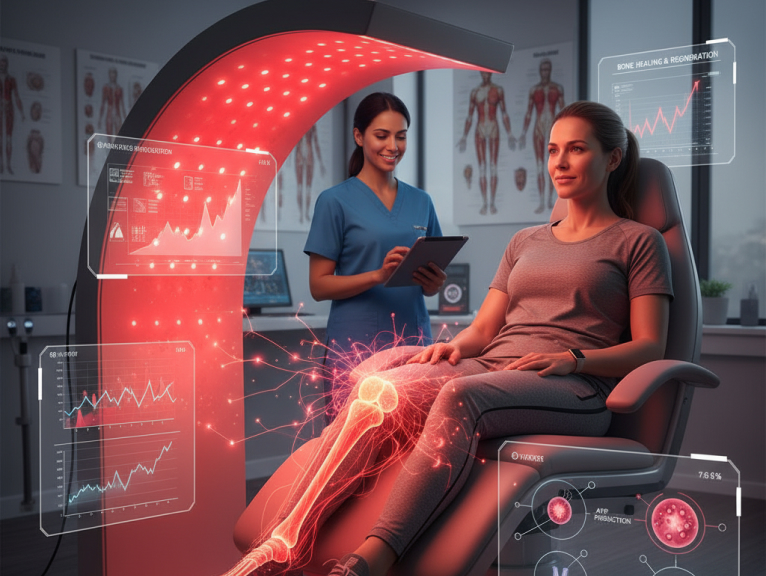
20 Years of Producing the Highest Quality, Most Reliable, and Effective LED mask.
Discover how light therapy, particularly red and near-infrared light, is improving bone healing, density, and strength. Learn about the mechanisms, clinical studies, and practical applications in bone health and recovery.

Bone health is essential for overall well-being. Bones provide structure, protect vital organs, and enable movement. However, conditions such as osteoporosis, fractures, and bone defects can greatly impact quality of life. These conditions can cause chronic pain, disability, and an increased risk of future injury.
Traditionally, treatments for bone-related issues include medications, physical therapy, and surgery. However, these methods may not always be sufficient for promoting long-term recovery or addressing the root causes. As a result, new therapies like light therapy, specifically photobiomodulation (PBM), are gaining attention for their ability to improve bone health and speed up healing.
Photobiomodulation is a non-invasive therapy that uses low-level light, often in the red or near-infrared spectrum, to stimulate biological processes within tissues. When light is absorbed by tissues, it enhances mitochondrial activity and increases the production of adenosine triphosphate (ATP), the energy molecule that powers cells. This increase in cellular energy accelerates tissue repair, reduces inflammation, and promotes healing.
In the context of bone health, PBM is especially effective because it can stimulate bone-forming cells (osteoblasts), promote collagen production, and enhance blood circulation—all of which support bone regeneration and healing.
The therapeutic effects of light therapy for bone healing are multifactorial, involving several key mechanisms:
Osteoblasts are the cells responsible for bone formation. Red and near-infrared light therapy can stimulate osteoblast activity, enhancing bone mineralization and accelerating fracture healing.
Collagen is a vital component of the bone matrix, providing structure and strength. PBM has been shown to increase collagen production, helping to strengthen bones and improve healing after fractures.
Light therapy helps promote the formation of new blood vessels (angiogenesis), increasing oxygen and nutrient delivery to the healing bone. This improved circulation supports tissue repair and bone regeneration.
Chronic inflammation can impede bone healing. PBM has anti-inflammatory properties that help reduce swelling and create an optimal healing environment for bones.
There is a growing body of evidence that supports the use of PBM in bone healing and regeneration. One of the most notable studies, conducted in 2013 in São Paulo, Brazil, investigated the effects of red (≈660–690 nm) and near-infrared (≈790–830 nm) light on bone repair in rats.
Researchers divided 45 rats into three groups: one group received no light treatment, the second received red light treatment, and the third received near-infrared light treatment. The rats underwent osteotomy (bone cutting) and were monitored for 7 to 14 days.
These results suggest that red and near-infrared light can stimulate bone healing by promoting energy production in bone cells, improving circulation, and modulating inflammation. This is why PBM is becoming increasingly popular in professional sports and rehabilitation for shortening recovery times after bone injuries.
These devices deliver light through the skin to stimulate the underlying bone tissues. These are often used to treat fractures, osteoarthritis, and other bone-related conditions. PBM devices are widely available, including handheld lasers and LED panels.
PBM can be applied directly during surgeries to enhance bone healing and reduce post-surgical complications. This method is used in orthopedic procedures to stimulate bone growth and repair fractures or defects.
For individuals recovering from bone injuries, home-based PBM devices provide a convenient and cost-effective treatment option. These devices allow patients to continue their therapy from the comfort of their homes.
Professional-grade PBM treatments are available at clinics specializing in rehabilitation and pain management. These treatments often involve more powerful devices and can be tailored to treat complex bone issues effectively.
Q1: Is light therapy safe for bone healing?
A1: Yes, PBM is safe when used as directed. It is non-invasive, with minimal side effects, making it ideal for bone healing and regeneration.
Q2: How long does it take to see results from light therapy?
A2: The duration of treatment varies, but many individuals begin to notice improvements in pain reduction and healing within a few weeks of consistent PBM therapy.
Q3: Can light therapy replace traditional treatments for bone injuries?
A3: No, PBM should be used as an adjunctive therapy in combination with traditional treatments like surgery, medication, and physical therapy.
Q4: How often should I use light therapy for bone health?
A4: Typically, PBM devices should be used 3-5 times a week. The exact frequency depends on the specific bone condition being treated.
Q5: Are there any contraindications for light therapy?
A5: Light therapy is generally safe, but individuals with certain conditions, such as photosensitivity, should consult with a healthcare provider before using PBM.
Photobiomodulation offers a promising, non-invasive treatment option for improving bone health and accelerating recovery from fractures and other bone-related conditions. By stimulating cellular processes that promote healing, reduce inflammation, and strengthen bone structure, PBM may become an essential tool in bone health management.
As more research continues to support its efficacy, light therapy could play a key role in revolutionizing the way bone injuries and conditions are treated.
For more information on photobiomodulation and its applications in bone health, consider exploring the following resources:
References:
